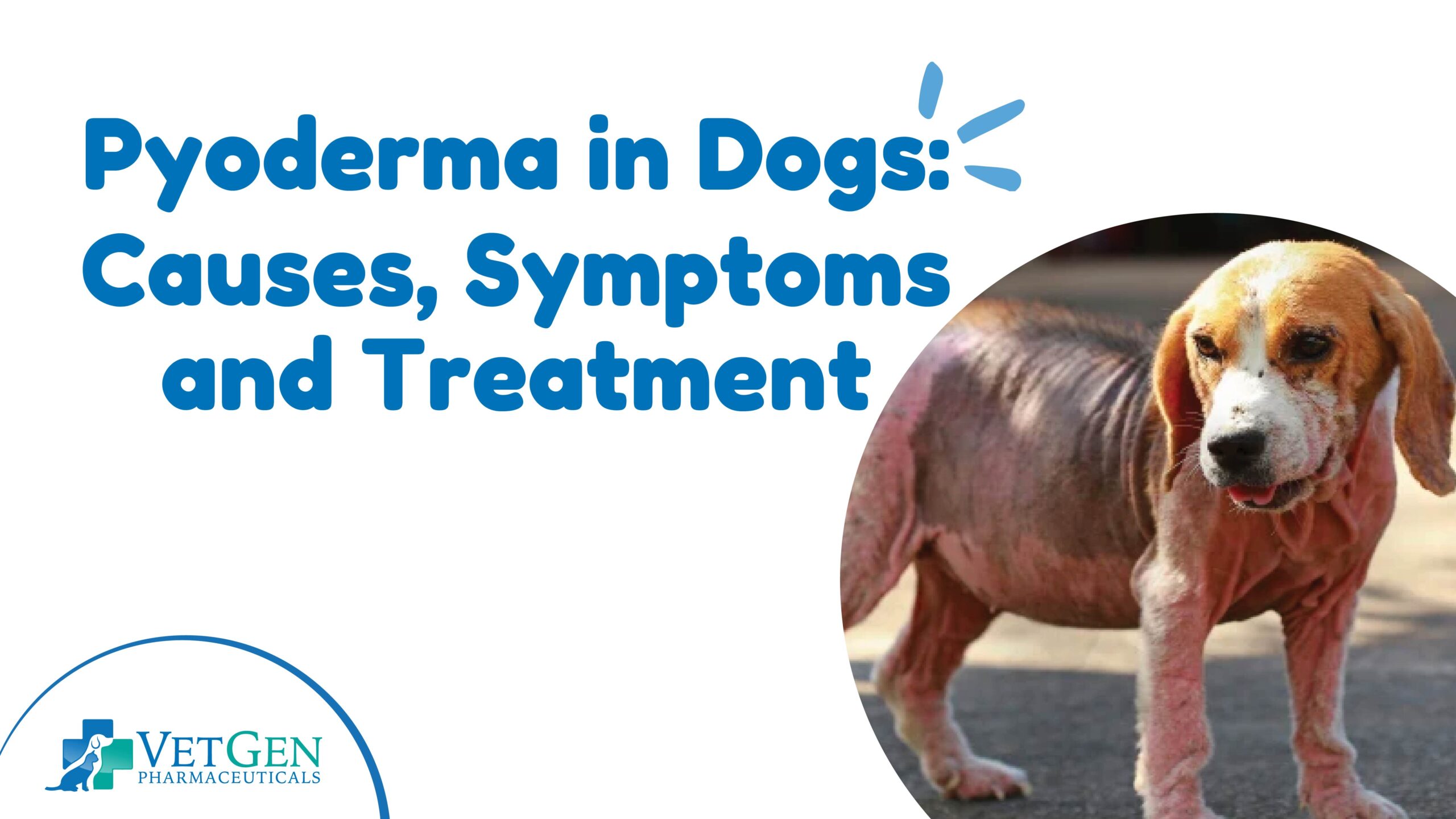Pyoderma, in simple words, happens to be a bacterial infection occurring on the skin of puppies and adult dogs. When this infection happens in the puppies, it is called “Impetigo”. This skin problem is typically identified by an extreme growth of bacteria called Staphylococcus intermedius(pseudintermedius).
Meanwhile, several other kinds of bacteria are also linked to Pyoderma. You can see if your dog has itchy skin, then it might show scaly appearance, and even pustules and ulcers in a few instances. Veterinarians are of the view that the problem of Pyoderma in dogs becomes worsened by moist and warm climatic conditions.
Although this problem can be treated by a combination of antibiotics, it can have the likelihood of recurrence, especially if its root cause is not looked into. The skin issue can mask other conditions as well. That is, the dog might become a victim of the vicious cycle of treatment in case this condition is not treated. Apart from antibiotics, certain dog supplements meant for dry skin have shown successful results in preventing Pyoderma.

Symptoms and Signs of Pyoderma
Some of the common symptoms and signs of pyoderma are:
- Swelling and Redness: The affected region of the skin is normally swollen and red. It is because of inflammation, a natural reaction to the immune system of the body to infection.
- Formation of Pus: One of the indicators of pyoderma is having pus-filled lesion which can be in the form of impetigo, abscesses, or pustules. Pus can be yellow or white and shows that the immune system is giving its natural fight against the bacterial infection.
- Tenderness and Pain: The area having infection is normally painful and feels tender when touched. It is due to inflammation and infection in the skin tissues.
- Itchiness: It can be quite itchy. If the affected skin is scratched, it can become worse and might spread to the adjoining skin.
- Warmth: The affected skin can feel hot or warm when touched which is due to inflammation.
- Skin Lesions: Different types of lesions on the skin can happen with pyoderma. These can be crusted areas, erosions, and ulcers. The lesion type depends on the infection’s severity and depth.
- Odor: Pyoderma may, in few cases, create a foul smell, especially when there is pus accumulation and the infection is quite severe.
- Systemic Symptoms: Although quite rare, some severe cases of this problem may result in system symptoms like lethargy, fever, and a feeling of unwell. It can mean widespread infection.
- Lymphadenopathy: The adjacent lymph nodes can feel tender and swollen as the body fights the infection in a few cases.
- Hair Loss: In animals, and quite rarely in humans, it can result in hair loss near the affected region as a result of damage to hair follicles and the skin.
Possible Reasons of Pyoderma
- Bacterial Infection: One of the most direct reasons for pyoderma is a bacterial infection, specifically involving Staphylococcus aureus or Streptococcus pyogenes. These may enter the skin through abrasions, or small cuts in the skin barrier.
- Compromised Skin Barrier: Any cuts, underlying skin conditions including eczema, wounds, insect bites, or cuts can lead to pyoderma.
- Poor hygiene: Risk of skin infections like pyoderma can increase with inadequate bathing or washing as the bacteria multiply on dirty skin.
- Moist Environment: Bacteria grow in moist environment conditions thereby making sweaty skin regions or skin folds vulnerable to development of infections like pyoderma.
- Immunocompromised State: Persons with weak immunity due to conditions like HIV/AIDS or diabetes are prone to such infections.
Diagnosis of pyoderma demands a detailed evaluation that begins with a comprehensive examination and history taking. The patient is asked about their medical history, start and progression of the problem, any history of skin problems, and lifestyle factors that may lead to skin problems. All these details can help in knowing potential underlying reasons or worsening factors.
The physician examines the affected area closely during the physical examination for evaluation of the extent and severity of the infection. They search for swelling, redness, pus-filled lesions, or any other signs of systemic involvement including lymph node enlargement or fever. Crucial clues for diagnosis are arrived at by observing the nature of skin lesions, like ulcers, erosions, or pustules and their occurrence across the skin.
For confirmation of the diagnosis and identification of the specific bacteria type involved, the doctor might prescribe other diagnostic tests. It might involve taking a pus sample or skin lesion swabs to be sent further for sensitivity and culture testing. The test enables identifying the bacteria spreading the infection and aids in knowing the best antibiotic treatment.
Other tests may be blood tests for checking the signs of inflammation or infection throughout the body, especially in case of severe infection or any symptoms of systemic involvement.

Prevention and Treatment of Pyoderma
Topical Therapy
As per ISCAID’s (International Society for Companion Animal Infectious Diseases), localized and mild cases of superficial bacterial pyoderma in dogs need to be treated first through topical therapy prior to any other treatment.
Topical therapies like wipes, mousses, and sprays infused with disinfectants are easily available at vet pharmacies. The infected regions can be shaved for easy absorption of topical medicine.
Grooming
A few scientific studies suggest that some shampoos can help in prevention of bacterial infestation even after getting washed. Typically, shampoos with chlorhexidine and miconazole are said to be equally effective as antibiotic medications. Its best to leave the shampoo for 15 minutes on the body of the dog before rinsing.
Antibiotics
In extreme situations, oral antibiotics may be prescribed by the vet for several weeks or more after the pustules and lesions go away. It might be a two-pronged approach meant for elimination of the underlying conditions, allergies, and hormonal imbalances. You might see antibiotic-resistant bacteria.
As per DVM, Dipl. ACVD, Director of Clinical Studies at Coastal Veterinary Dermatology and Ear Clinic, Michael Rossi, the chance of development of resistance to antibiotics might be reduced if topical therapy and systemic therapy are administered.
The veterinarian has to make sure that correct dosage and duration of systemic antibiotics is given. If they are found to be ineffective, then they should undertake aerobic bacteria culture for finding out any other line of antibiotics for prescription. This is crucial for creation of unrequired antimicrobial resistance.
Recovery of Pyoderma

Make a convenient place for the recovery of your pet and ensure it has access to water and healthy food. Make sure to abide by your vet’s recommendations for medication.
Dog supplements for dry skin can also help in reduction of rashes and irritation, thereby helping in speeding up your dog’s recovery.
Never avoid it when you see the symptoms have vanished. Make sure to follow healthy practices for prevention of pyoderma reoccurrence to the minimum.
We, at VetGen Pharmaceuticals, ensure to offer ideal care for raising a healthy, happy, and active dog. No wonder, we feel happy to go that extra mile for creating the best dog supplements for dry skin and certain other supplements for prevention and treatment of different conditions. Our products abide by the highest practices and standards of the industry. Feel free to get in touch with us for any queries.
References
- Marissa Heflin, Veterinary Practice News (2019): “Getting to The Root of Pyoderma”. Retrieved from https://www.veterinarypracticenews.com/getting-to-the-root-of-pyoderma/
- Wolfgang Baumer et.al., Department of Molecular Biomedical Sciences, College of Veterinary Medicine, North Carolina State University (2019): “Efficacy study of a topical treatment with a plant extract with antibiofilm activities using an in vivo model of canine superficial pyoderma”. Retrieved from https://onlinelibrary.wiley.com/doi/full/10.1111/vde.12808
- David Grant, Veterinary Practice (2018): “Canine Deep Pyoderma”. Retrieved from https://veterinary-practice.com/article/canine-deep-pyoderma
- N.J. Day, Department of Pathology and Microbiology, University of Bristol (1993): “An immunopathological study of deep pyoderma in the dog”. Retrieved from https://www.sciencedirect.com/science/article/abs/pii/0034528894901902
- Dr. Sarah Wooten, Hills Pet (2019): “Pyoderma in Dogs: What You Need to Know”. Retrieved from https://www.hillspet.com/dog-care/healthcare/pyoderma-in-dogs






